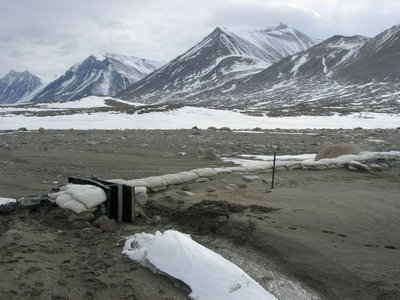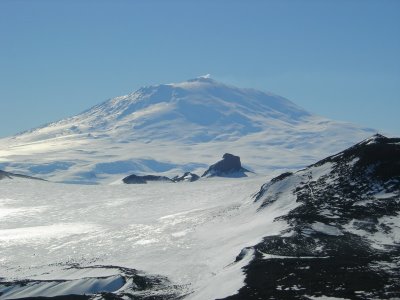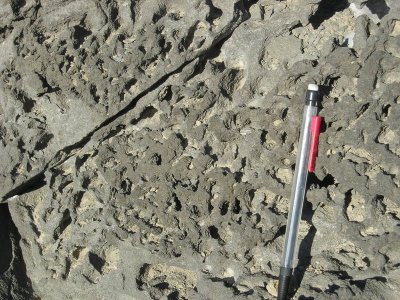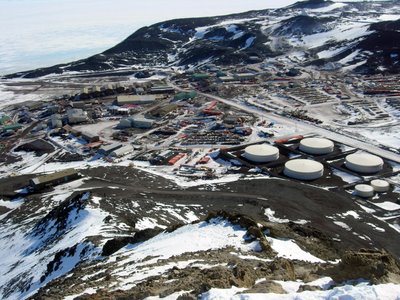

Lost Seal stream control structure- dam and flume
Each stream gauge is contained in a large plywood box that is secured to the ground with rope tie-downs. When I talk about a ‘stream gauge,’ I mean the box and everything that is contained within it- explanations to follow. The stream gauge is located on the shore of the stream, next to what hydrologists call a control structure. The control structure is located within the stream flow channel and usually consists of sandbags and tarps that direct all of the flow to one aperture in the wall, in this case a flume. The flume is an hourglass shaped channel with a staff plate that you can read to tell you the height of the water, or stage. What we are interested in though, is not the stage, it is the volume of water per time, or discharge. Saying “the water was flowing at a height of 1.3 feet” tells us a lot less than “the discharge of the stream was 4 cubic feet per second.” Hydrologists use a mathematical relationship called a rating curve to relate stage and discharge. Every time we visit a stream, we manually measure the stream discharge (future post about how we do this) and read the staff gauge to get the stage. This stream visit will give us one point on the rating curve, a plot with discharge on the X-axis and stage on the Y-axis. Enough visits to the stream and we have enough points on our rating curve to have a clear picture of the stage-discharge relationship in that particular stream (it will be some sort of readable relationship, not just a cloud of dots). Therefore next time we go to the stream, we can just read the staff plate because using our graph, we can figure out what the discharge is.

Example of a rating curve from www.geologyeducation.com
The reason we have a gauge box is to help us measure stream parameters more often than whenever we have time to hike out to the stream. We have the stream gauge set up to take readings once every 15 minutes- 96 readings per day! Inside the gauge box are instruments that measure three things about the stream: stage, water temperature, and specific conductance. There are two wires and one small tube that run from the gauge box to the bottom of the flume. To measure stage, a tiny bubble of compressed nitrogen gas is sent through the tube and an instrument in the gauge box measures the pressure required to emit this bubble, essentially measuring the height of water (or stage) above where the bubble comes out. Convert all these stage measurements to discharge using our rating curve, and we have 96 discharge measurements every day! The specific conductance sensor sends an electric pulse through the water and measures how fast it travels, telling us how much material is dissolved in the water. The temperature sensor is self-explanatory. Having 96 measurements a day really helps us elucidate the patterns of the stream and can help us figure out if something anomalous happens. Using all of our measurements from the first trickle of meltwater to the end of the summer melting season, we can also get a good idea of how much total water came through the system. This can be very helpful if the source for the stream is a glacier because then we have a good idea of how much it melted.
 Half of Lake Hoare Camp (Canada glacier in the background)
Half of Lake Hoare Camp (Canada glacier in the background) The Taylor Valley (Lake Hoare in the foreground)
The Taylor Valley (Lake Hoare in the foreground)

 Our quinzee hut! We added the arch out of ice blocks as a fun technical challenge. Notice the fact that the entrance is below the ground surface- this is because you want the hot air you produce inside to stay inside! The lowered entrance serves as a cold air sink.
Our quinzee hut! We added the arch out of ice blocks as a fun technical challenge. Notice the fact that the entrance is below the ground surface- this is because you want the hot air you produce inside to stay inside! The lowered entrance serves as a cold air sink.  Whiteout simulation
Whiteout simulation

 View of McMurdo Station from Observation Hill
View of McMurdo Station from Observation Hill


